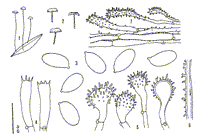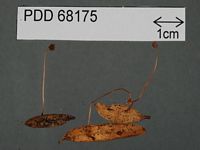|
 Marasmius podocarpicola Marasmius podocarpicola
SynonymsMarasmius podocarpi
BiostatusPresent in region - Indigenous. Endemic
Images (click to enlarge)
Caption: Fig. 17 (1-7). Marasmius podocarpi Desjardin & E. Horak (PDD, holotype).- 1, 2. Basidiomes.-
3. Basidiospores.- 4. Basidia.- 5. Cheilocystidia.- 6. Cortical hypha of stipe. -7. Pileipellis. | 
Caption: Dried type specimen
Owner: Herb PDD |
Article: Desjardin, D.E.; Horak, E. (1997). Marasmius and Gloiocephala in the South Pacific Region: Papua New Guinea, New Caledonia, and New Zealand taxa. Bibliotheca Mycologica 168: 152 p.
Description: Pi1eus 2-4 mm diam, hemispherical to convex; disc depressed or subumbilicate in age; margin plicate;
surface dull, dry, glabrous; pale brown to dark brown overall with reddish brown tones. Texture
membranaceous, tough; context thin.- Lamellae adnexed to adnate, close (8-12) with 1 series of
lamellulae, narrow to moderately broad, non-collariate, cream to pale reddish brown; edges even to
subfimbriate, concolorous.- Stipe15-25 x 0.2-0.4 mm, central, cylindrical, equal, wiry, tough, solid,
minutely pruinose overall, not gelatinized, insititious; apex pale brown, fuscous elsewhere;
rhizomorphs absent. Odor and taste not distinctive.
Basidiospores 8.0-9.5 x 4.5-5.0 µm, ovoid to ellipsoid, smooth, thinwalled, hyaline, inamyloid.-
Basidia 25-30 x 7-8 µm , cylindrical to subclavate, 4-spored, clamped.- Cheilocystidia numerous,
similar to Rotalis-type cells, 15-30 x 8-14 µm , broadly clavate to slightly irregular in outline,
hyaline, thin-walled; diverticula 1-3 x 1.0-1.5 µm , cylindrical to irregular, seldom forked, hyaline.-
Pleurocystidia absent.- Pileipellis a Rameales-structure with repent to suberect, diverticulate
terminal cells, 20-45 x 6-10 µm, subcylindrical to clavate or irregular in outline, brown, dextrinoid;
diverticula 2-5 x 0.5-1.0 µm, irregularly cylindrical, seldom forked; subcuticular hyphae with brown
pigment incrustations.- Pileal and lamellar trama dextrinoid.- Stipe tissue monomitic; cortical
hyphae cylindrical, diverticulate, pale brownish orange to brown, weakly dextrinoid, thick-walled;
diverticula 1-6 x 1-2 µm, cylindrical, sometimes forked; medullary hyphae hyaline, weakly
dextrinoid.- Cau1ocystidia absent.- Clamp connections present.
Habitat: Habit, habitat and distribution.- Solitary, in groups on rotting needles of Podocarpus totara
(Podocarpaceae) or on rotting needles of Podocarpus hallii (Podocarpaceae). New Zealand.
Notes: Diagnostic features of M. podocarpi include: a small, brown, plicate pileus; cream to pale reddish
brown, close, non-collariate lamellae; a fuscous, pruinose, insititious stipe lacking rhizomorphs;
broad basidiospores; numerous cheilocystidia resembling Rotalis-type cells; a pileipellis composed
of a Rameales-structure; and growth on Podocarpus species. Marasmius podocarpi is allied with M.
earlei Murrill described from Jamaica. The latter species differs, however, in forming a white pileus
with pale brown disc, more numerous (10-24), white lamellae, narrower basidiospores (3.5-4.0 µm),
and basidiome formation on dicotyledonous wood (fide Singer, 1976).
Article: Pennycook, S.R. (2003). Nomenclatural revisions of New Zealand agarics and boletes. New Zealand Journal of Botany 41(3): 501-502 (http://www.rsnz.org/publish/abstracts.php).
Description: Horak (1997) described the New Zealand
agaric Marasmius podocarpi, which is an illegitimate later homonym, requiring a nomen novum.
Marasmius podocarpicola Pennycook, nom. nov.ç Marasmius podocarpi Desjardin &
E.Horak,Biblioth. Mycol. 168, 126 (1997), nom. illegit., non Singer 1952.
ETYMOLOGY: referring to the substrate genus, Podocarpus.
|